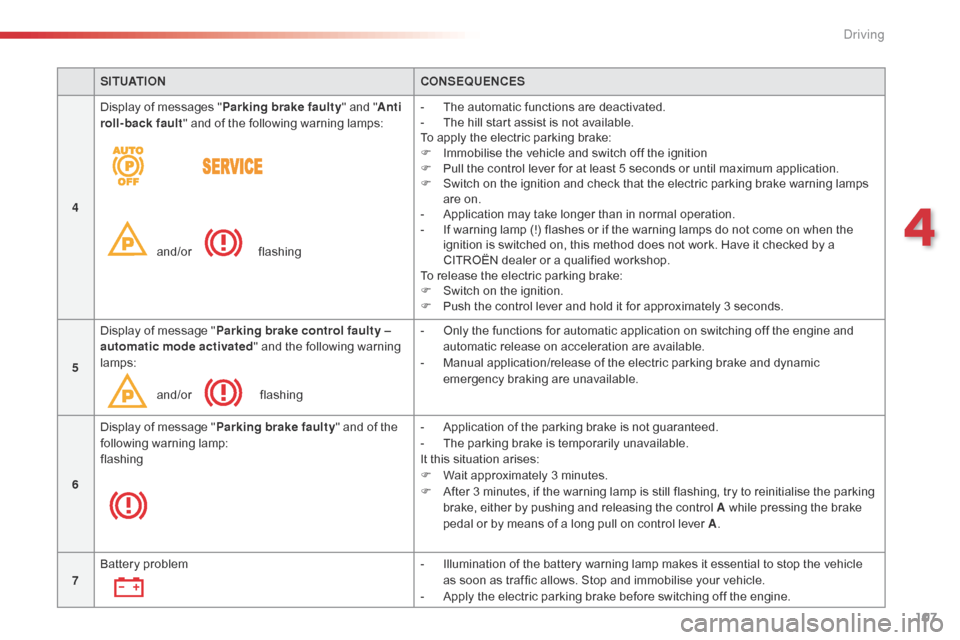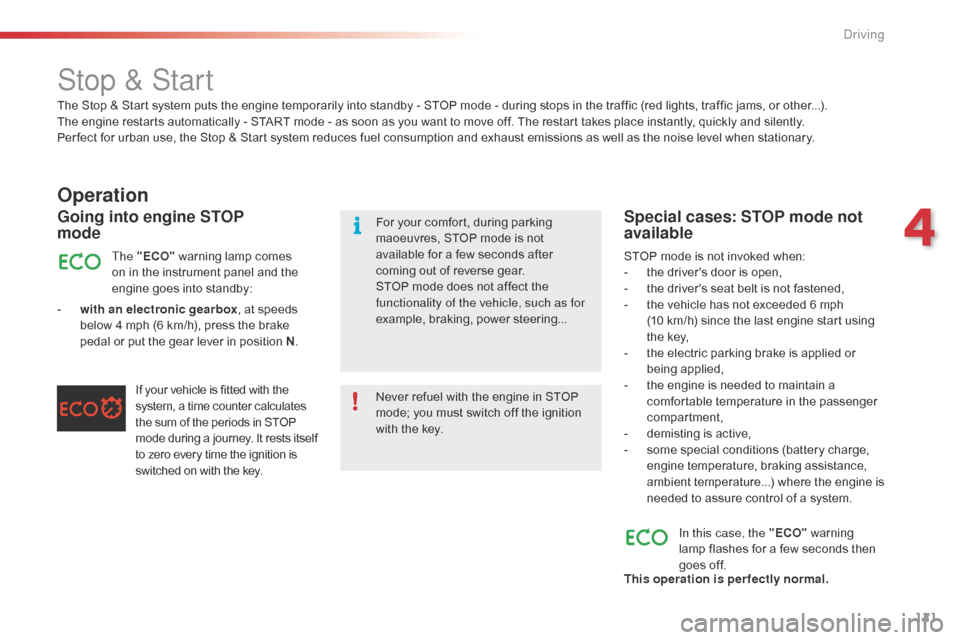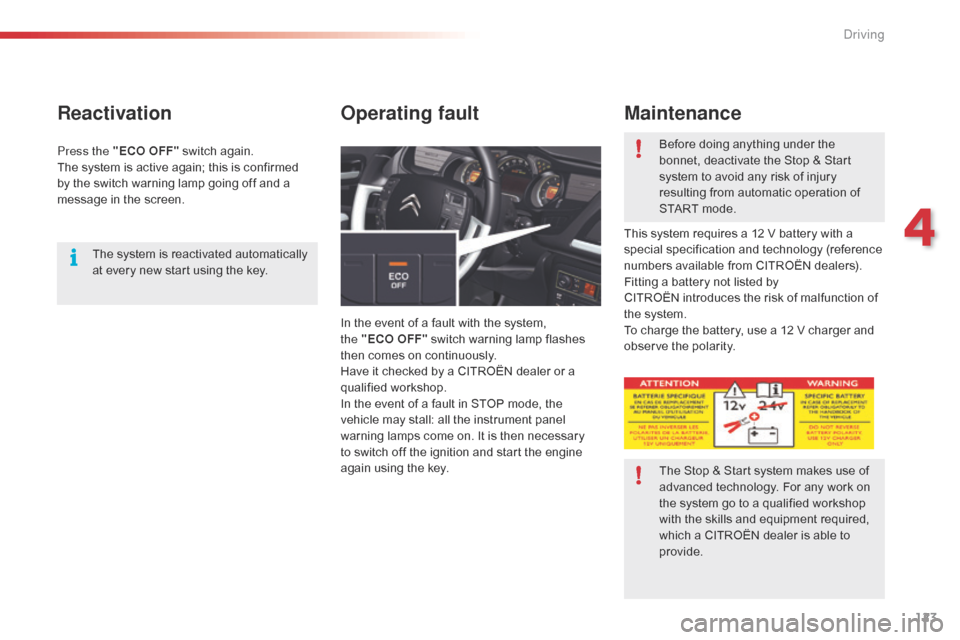stop start Citroen C5 2015 (RD/TD) / 2.G User Guide
[x] Cancel search | Manufacturer: CITROEN, Model Year: 2015, Model line: C5, Model: Citroen C5 2015 (RD/TD) / 2.GPages: 344, PDF Size: 12.95 MB
Page 61 of 344

59
C5_en_Chap03_ergo-et-confort_ed01-2014
Electric adjustments
To adjust the electric seats, switch on the
ignition or start the engine if the vehicle has
gone into economy mode.
Seat adjustments are also possible for a short
period after opening one of the front doors or
switching off the ignition.
1.
A
djustment of the seat height and
angle, and longitudinal position
R
aise or lower the front of the control to
adjust the seat cushion angle.
R
aise or lower the rear of the control to
raise or lower the seat.
S
lide the control for wards or backwards to
move the seat for ward or back.
2.
A
djustment of the backrest angle
M
ove the control for wards or backwards to
adjust the backrest angle.
3.
A
djustment of the angle of the top of
the backrest
M
ove the control for wards or backwards to
adjust the angle of the top of the backrest. Before moving the seat backwards,
ensure that there is nothing that might
prevent the full travel of the seat, so
as to avoid the risk of of jamming the
seat caused by the presence of objects
on the floor behind the seat or rear
passengers. If the seat jams, stop the
movement immediately.
Move the control:
-
F
or wards or backwards to increase or
reduce the lumbar support.
-
U
pwards or downwards to raise or lower
the lumbar support zone.
4.
A
djustment of lumbar support
T
his function allows you to independently
adjust the height and level of lumbar
support.
3
Ease of use and comfort
Page 74 of 344

72
C5_en_Chap03_ergo-et-confort_ed01-2014
F Press control 7, with the
engine running, to demist
the rear screen and the door
mirrors. The indicator lamp
comes on.
7. Rear demisting - defrosting
This function enables you to isolate the passenger
compartment from exterior fumes and odours.
However, demisting resumes when the engine
is switched on again.
Switch off the rear screen and door mirrors
demisting when you consider this necessary
as low current consumption reduces fuel
consumption. F
P
ress control 8 to set the air
intake mode, the indicator
lamp comes on.
Demisting is switched off automatically to
prevent an excessive consumption of current
and in relation to the ambient temperature.
It may be stopped by pressing control 7 again
or when the engine is switched off. It must be cancelled as soon as possible to
permit renewal of the air in the passenger
compartment and demisting.
The heated rear screen operates independently
of the air conditioning system.
With Stop & Start, when demisting has
been activated, the STOP mode is not
available. You can store the air conditioning
settings. Refer to the "Storing driving
positions" section.When starting with the engine cold,
the flow will reach its optimum level
gradually to prevent an excessive
distribution of cold air.
When entering the vehicle after it has
been parked for a fairly long period, if
the interior temperature is very different
from your comfort setting there is
no need to change the temperature
displayed in order to quickly reach the
level of comfort required. The system
automatically uses its maximum
per formance to correct the difference in
temperature as quickly as possible.
The water resulting from the air
conditioning condensation is
discharged via an opening provided
for this purpose; therefore, a puddle of
water may form underneath the vehicle
when stationary.
In all seasons, if the weather is cool,
the air conditioning is useful as it
removes the humidity from the air
and the condensation. Avoid driving
for prolonged periods with the air
conditioning switched off.
8. Intake of exterior air /
Recirculation of interior air
Ease of use and comfort
Page 78 of 344

76
C5_en_Chap03_ergo-et-confort_ed01-2014
9. Front demisting - defrosting
In certain cases, the "AUTO"
mode may not be sufficient to
demist or defrost the windows
(humidity, several passengers,
i c e).
8. Rear demisting - defrosting
Switch off the rear screen and exterior mirrors
demisting when you consider this necessary
as low current consumption reduces fuel
consumption. The heated rear screen operates
independently of the air
conditioning system.
F Press control
8, with the engine running, to
demist the rear screen and the mirrors. The
indicator lamp comes on.
Demisting is switched off automatically to
avoid excessive consumption of current and
depending on the exterior temperature.
It may be stopped by pressing control 8 again
or when the engine is switched off.
In this latter case, the demisting resumes if the
engine is switched on again within one minute. F
P
ress control 9 to clear the windows
quickly. The indicator lamp comes on.
This system controls the temperature, air flow
and intake and distributes the ventilation to the
windscreen and front side windows.
Resuming manual control exits from the
"Demisting" mode. It must be cancelled as
soon as possible to permit renewal of the air in
the passenger compartment and demisting.
Pressing one of the controls 1a and 1b returns
the system to the "AUTO" mode.
With Stop & Start, when demisting has
been activated, the STOP mode is not
available. When starting with the engine cold,
air flow will reach its optimum level
gradually to prevent an excessive
distribution of cold air.
When entering the vehicle after it has
been parked for a fairly long period, if
the interior temperature is very different
from your comfort setting there is
no need to change the temperature
displayed in order to quickly reach the
level of comfort required. The system
automatically uses its maximum
per formance to correct the difference in
temperature as quickly as possible.
The water resulting from the air
conditioning condensation is discharged
via an opening provided for this purpose;
therefore, a puddle of water may form
underneath the vehicle when stationary.
In all seasons, if the weather is cool,
the air conditioning is useful as it
removes the humidity from the air
and the condensation. Avoid driving
for prolonged periods with the air
conditioning switched off.
Ease of use and comfort
Page 110 of 344

96
C5_en_Chap04_conduite_ed01-2014
A few driving recommendations
Driving on flooded
roads
We strongly advise against driving on flooded
roads, as this could cause serious damage
to the engine or gearbox, as well as to the
electrical systems of your vehicle. Observe the driving regulations at all times and
remain vigilant whatever the traffic conditions.
Pay close attention to the traffic and keep your
hands on the wheel so that you are ready to
react at any time to any eventuality.
On a long journey, a break every two hours is
strongly recommended.
In difficult weather, drive smoothly, anticipate
the need to brake and increase the distance
from other vehicles.
Important!
Never drive with the parking brake
applied - Risk of overheating and
damage to the braking system!
Do not park or run the engine when
stationary in areas where inflammable
substances and materials (dry grass,
dead leaves...) might come into contact
with the hot exhaust system - Risk
of fire!
Never leave a vehicle unsupervised
with the engine running. If you have
to leave your vehicle with the engine
running, apply the parking brake
and put the gearbox into neutral or
position
N or P, depending on the type
of gearbox.
If you are obliged to drive through water:
-
c
heck that the depth of water does not
exceed 15 cm, taking account of waves
that might be generated by other users,
-
d
eactivate the Stop & Start system,
-
d
rive as slowly as possible without stalling.
In all cases, do not exceed 6 mph
(10 km/h),
-
d
o not stop and do not switch off the
engine.
On leaving the flooded road, as soon as
circumstances allow, make several light brake
applications to dry the brake discs and pads.
If in doubt on the state of your vehicle, contact
a CITROËN dealer or a qualified workshop.
Driving
Page 111 of 344

97
C5_en_Chap04_conduite_ed01-2014
Anti-theft protection
Electronic engine immobiliser
The key contains an electronic chip which has
a special code. When the ignition is switched
on, this code must be recognised in order for
starting to be possible.In the event of a fault, you are
informed by illumination of this
warning lamp, an audible signal and
a message in the screen.
In this case, your vehicle will not start; contact
a CITROËN dealer as soon as possible.
Starting-switching off the engine
Keep safely, away from your vehicle,
the label attached to the keys given to
you on acquisition of the vehicle.
Ignition switch
It has 3 positions:
- p osition 1 (Stop) : insert and removing
the
key,
-
p
osition 2 (Ignition on) : steering column
unlocked, ignition on, Diesel preheating,
engine running,
-
p
osition 3 (Starting) .
Ignition on position
It allows the use of the vehicle's electric
equipment or portable devices to be charged.
Avoid attaching heavy objects to the
key, which would weigh down on its
blade in the ignition switch and could
cause a malfunction.
This electronic engine immobiliser locks the
engine management system a few minutes
after the ignition is switched off and prevents
starting of the engine by anyone who does not
have the key.
Once the state of charge of the battery drops
to the reserve level, the system switches to
energy economy mode: the power supply is
cut off automatically to preserve the remaining
battery charge.
4
Driving
Page 121 of 344

107
C5_en_Chap04_conduite_ed01-2014
SITUATIONCONSEQUENCES
4 Display of messages "
Parking brake faulty" and "Anti
roll-back fault" and of the following warning lamps:
and/or
f
lashing-
T
he automatic functions are deactivated.
-
T
he hill start assist is not available.
To apply the electric parking brake:
F
I
mmobilise the vehicle and switch off the ignition
F
P
ull the control lever for at least 5 seconds or until maximum application.
F
S
witch on the ignition and check that the electric parking brake warning lamps
are on.
-
A
pplication may take longer than in normal operation.
-
I
f warning lamp (!) flashes or if the warning lamps do not come on when the
ignition is switched on, this method does not work. Have it checked by a
CITROËN dealer or a qualified workshop.
To release the electric parking brake:
F
S
witch on the ignition.
F
P
ush the control lever and hold it for approximately 3 seconds.
5 Display of message "
Parking brake control faulty –
automatic mode activated " and the following warning
lamps:
and/or
f
lashing-
O
nly the functions for automatic application on switching off the engine and
automatic release on acceleration are available.
-
M
anual application/release of the electric parking brake and dynamic
emergency braking are unavailable.
6 Display of message "
Parking brake faulty " and of the
following warning lamp:
flashing -
A
pplication of the parking brake is not guaranteed.
-
T
he parking brake is temporarily unavailable.
It this situation arises:
F
W
ait approximately 3 minutes.
F
A
fter 3 minutes, if the warning lamp is still flashing, try to reinitialise the parking
brake, either by pushing and releasing the control A while pressing the brake
pedal or by means of a long pull on control lever A .
7 Battery problem
-
I
llumination of the battery warning lamp makes it essential to stop the vehicle
as soon as traffic allows. Stop and immobilise your vehicle.
-
A
pply the electric parking brake before switching off the engine.
4
Driving
Page 135 of 344

121
C5_en_Chap04_conduite_ed01-2014
Stop & Start
Operation
- with an electronic gearbox, at speeds
below 4 mph (6 km/h), press the brake
pedal or put the gear lever in position N .
Going into engine STOP
mode
The "ECO" warning lamp comes
on in the instrument panel and the
engine goes into standby:
If your vehicle is fitted with the
system, a time counter calculates
the sum of the periods in STOP
mode during a journey. It rests itself
to zero every time the ignition is
switched on with the key.
Special cases: STOP mode not
available
In this case, the "ECO" warning
lamp flashes for a few seconds then
goes
off.
This operation is perfectly normal. STOP mode is not invoked when:
-
t
he driver's door is open,
-
t
he driver's seat belt is not fastened,
-
t
he vehicle has not exceeded 6 mph
(10 km/h) since the last engine start using
the key,
-
t
he electric parking brake is applied or
being applied,
-
t
he engine is needed to maintain a
comfortable temperature in the passenger
compartment,
-
d
emisting is active,
-
s
ome special conditions (battery charge,
engine temperature, braking assistance,
ambient temperature...) where the engine is
needed to assure control of a system.
The Stop & Start
system puts the engine temporarily into standby - STOP mode - during stops in the traffic (red lights, traffic jams, or other...).
The
engine restarts automatically - START mode - as soon as you want to move off. The restart takes place instantly, quickly and silently.
Per fect for urban use, the Stop & Start system reduces fuel consumption and exhaust emissions as well as the noise level when stationary.
Never refuel with the engine in STOP
mode; you must switch off the ignition
with the key. For your comfort, during parking
maoeuvres, STOP mode is not
available for a few seconds after
coming out of reverse gear.
STOP mode does not affect the
functionality of the vehicle, such as for
example, braking, power steering...
4
driving
Page 136 of 344

122
C5_en_Chap04_conduite_ed01-2014
- gear lever in position A or M, release the
brake pedal,
-
o
r gear lever in position N and the brake
pedal released, move the gear lever to
position A or M ,
-
o
r engage reverse gear.
Going into engine START
mode
The "ECO" warning lamp goes
off and the engine starts with an
electronic gearbox :
Special cases: START invoked
automatically
In this case the "ECO" warning
lamp flashes for a few seconds, then
goes
off.
This operation is perfectly normal. START mode is invoked automatically when:
-
t
he driver's door is open,
-
t
he driver's seat belt is not fastened,
-
t
he speed of the vehicle exceeds 7 mph
(11
km/h) with an electronic gearbox,
-
t
he electric parking brake is being applied,
-
s
ome special conditions (battery charge,
engine temperature, braking assistance,
ambient temperature...) where the engine is
needed for control of a system. At any time, press the "ECO OFF" switch to
deactivate the system.
This is confirmed by the switch warning lamp
coming on accompanied by a message in the
screen.
Deactivation
If the system has been deactivated
in STOP mode, the engine restarts
immediately.
Driving
Page 137 of 344

123
C5_en_Chap04_conduite_ed01-2014
Reactivation
In the event of a fault with the system,
the "ECO OFF" switch warning lamp flashes
then comes on continuously.
Have it checked by a CITROËN dealer or a
qualified workshop.
In the event of a fault in STOP mode, the
vehicle may stall: all the instrument panel
warning lamps come on. It is then necessary
to switch off the ignition and start the engine
again using the key.
Operating fault Maintenance
This system requires a 12 V battery with a
special specification and technology (reference
numbers available from CITROËN dealers).
Fitting a battery not listed by
CITROËN
introduces the risk of malfunction of
the system.
To charge the battery, use a 12 V charger and
observe the polarity. Before doing anything under the
bonnet, deactivate the Stop & Start
system to avoid any risk of injury
resulting from automatic operation of
START mode.
The Stop & Start system makes use of
advanced technology. For any work on
the system go to a qualified workshop
with the skills and equipment required,
which a CITROËN dealer is able to
provide.
The system is reactivated automatically
at every new start using the key.
Press the "ECO OFF" switch again.
The system is active again; this is confirmed
by the switch warning lamp going off and a
message in the screen.
4
Driving
Page 185 of 344

183
C5_en_Chap08_information_ed01-2014
Fuel tank
Capacity of the tank: approximately 71 litres*.
Low fuel level
When the minimum level
in the tank is reached, this
warning lamp comes on in the
instrument panel, accompanied
by an audible warning and a message in the
multifunction screen. When it first comes on,
there remains around 5 litres of fuel in the tank.
You must refuel to avoid running out of fuel.
F
P
ress at the top left corner, then pull on its
edge. F
t
urn the key a quarter turn to lock and
unlock the filler cap,
F
w
hen refuelling, place the cap on hook A,
F
f
ill the tank, but do not persist after the
third cut-off ; this could cause your vehicle
to malfunction.
While you are refuelling, the engine must be
stopped and the ignition switched off.
For a petrol engine with a catalytic
converter, unleaded fuel is compulsory.
Opening the fuel flap Refuelling
* 55 litres for Slovakia. Additions of fuel must be of at least
5 litres to be taken into account by the
fuel gauge.
The filler neck is narrower to ensure
that only unleaded petrol nozzles can
be put in.
Opening the filler cap may create a
noise of an inrush of air. This vacuum,
which is entirely normal, is caused by
the sealing of the fuel system.
With Stop & Start, never refuel with the
system in STOP mode; you must switch
off the ignition with the key.
8
Practical information